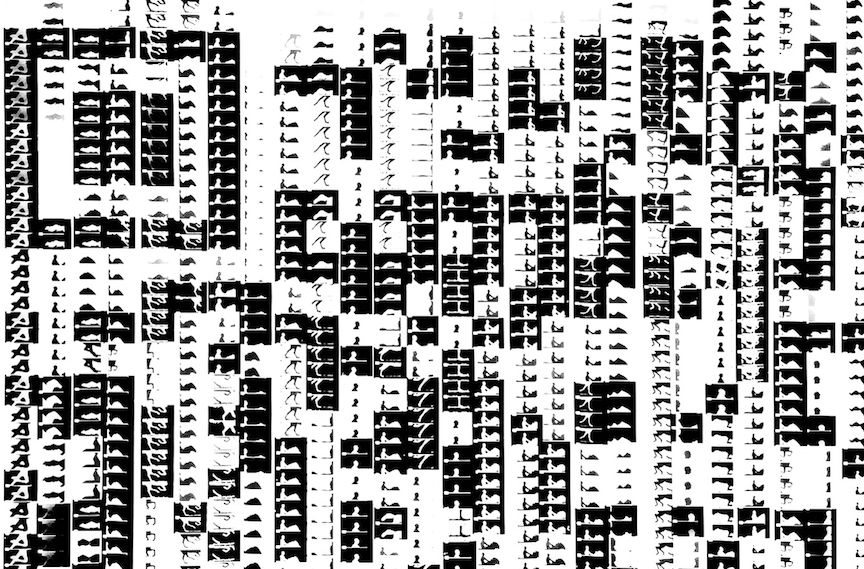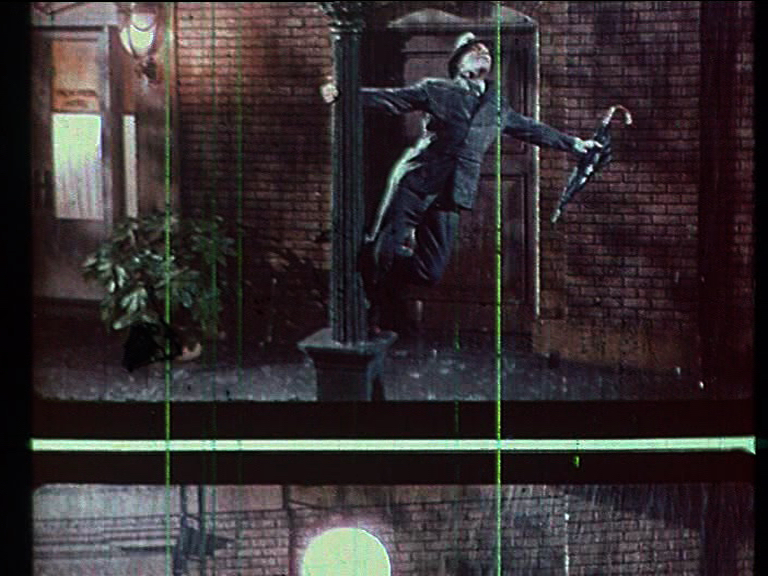Monday January 25, 7:30pm ET
Antoni Pinent
Celluloid Strips
Q&A with the artist via live chat on Thursday January 28, 7pm ET

Microscope is very pleased to present an online screening of selected works by Spanish artist and filmmaker Antoni Pinent. The screening will begin on Monday January 25th at 7:30pm ET and remain available for viewing until Thursday 28th at 10:30pm PT.
In this selection of ten films by Pinent spanning over 23 years — from his first work on 35mm film “Mi Primer 35mm” made in 1997 to his latest “SHARITS / KASSEL 2015” completed last year — film is often removed from its usual placement in the film projector and considered solely as a filmstrip, a surface able to hold static visual compositions, and as an object to look at under standard room illumination.
In works such as “QR CODE / FILM” and “GIOCONDA / FILM,” the film consists of a single image — a black QR code against a white background in the first, and Da Vinci’s “Mona Lisa,’ in the second — deconstructed into a grid of film frames from a series of filmstrips arranged side-by-side. The quite unique result when passed through the projector is the appearance of the shredding of a static image into strips of celluloid. Similarly, in “Música visual en vertical” grand staff musical notations are printed onto a 35mm filmstrip, the projected translation of which rushes vertically through the screen.
Other, but equally disruptive, structural operations are found in the artist’s 2013 “G/R/E/A/S/E” and the earlier “FILM QUARTET / POLYFRAME” (2008), both intensely reworked versions of found movies. In G/R/E/A/S/E — which is inspired by Dziga Vertov and Mimmo Rotella, among others — Pinent recuts, replays, hand-processes, optically reprints, and applies many other techiniques including hole-puncihg, scratching, erasing, marking and collaging to the 1978 cult musical “Grease.” The subdivision of the frame into four narrower horizontal areas frequently shifting independent from one another, allows for unexpected combinations of scenes and imagery often far apart from each other in the original timeline.
Described by Peter Tscherkassky as a prime example of “films that bring out the plasticity of the medium,” “FILM QUARTET / POLYFRAME” is a further investigation of the subdivision of the frame — usually intended as the “minimum unit of (cinematographic) time” — and the sonic depths of an out-of-sync optical track. The thoroughly dissected footage includes film snippets from Buñuel and Dali’s “Un Chien Andalou” (1929), Michael Snow’s “Wavelength” (1967), as well as brief appearances by the Pink Panther, Buster Keaton, Gene Kelly, and others collaged together in this piece made in celebration of the 50th anniversary of Bruce Conner’s “A Movie” (1958).
Pinent will be available for a Q&A with the audience via live chat on on Thursday January 28th at 7pm ET.
TO WATCH:
A “Watch Now” link will appear on this page on Monday January 25th at 7pm ET. Passes for viewing give full access to the video program and live chat.
General admission $8 (Valid through Thursday January 28, 10:30pm PT)Member admission $6 (Valid through Thursday January 28, 10:30pm PT)
_
Born in Lleida, Spain in 1975, Antoni Pinent is a film curator, programmer, producer and experimental filmmaker whose work has been screened at film festivals, cinematheques and museums worldwide, including at SFMoMA, San Francisco; Viennale, Vienna, Austria; BAFICI International Film Festival, Buenos Aires, Argentina; BFI London Film Festival, London, UK; Edinburgh International Film Festival; EXiS Experimental Film & Video Festival, Seoul, South Korea; among others. In 2008 Pinent received the Biennale Award from The Museum of Contemporary Cinema (MoCC. New York / Paris / Madrid). Since 2014 he has been working as a curator in collaboration with the Los Angeles Film Forum on the project “Ismo Ismo Ismo. Experimental Cinema in Latin America”. He current lives and works between Los Angeles and Venice (Italy).

Program:
Descenso
By Antoni Pinent
35mm film, color, sound, 2001-2002, 1 minute 06 seconds
Film made with analog 35mm photo camera framed vertically. The sound that arises is caused by the image extending over the optical sound track. The content focuses on the descent made from a building in the Plaza de España in Madrid, honoring the great Spanish filmmaker Iván Zulueta. — AP
Mi Primer 35mm
By Antoni Pinent
35mm film, color, silent, 1995-1997, 42 seconds
In this film the author looks back on his own artistic career, resuming his film (‘EXPERIMENTAL SKETCHES. 4,200 frames not moving away from home’), a semiabstract work, filmed on Super-8 format, and literally put onto 35mm format. […] Collage as radical realism in order for home-made Super-8 to force its way into 35mm market world. It is the film that travels, that sees the world, and sketches will no longer be sketches to everyone’s eyes because we will move from the daily the handmade to the industrial, from the diary to biography, from biography to hagiography, from hagiography to, inevitably, poetry. — Ana Isabel Aréjula, Madrid, 2002
FILM QUARTET / POLYFRAME
By Antoni Pinent
35mm film, color, sound, 2006-2008, 9 minutes 24 seconds
FILM QUARTET / POLYFRAME is conceived as a small cinematographic bomb attempting to question the established definition of frame as the minimum unit of (cinematographic) time by dynamiting it in four fragments. A step further in the so-called sub-genre practice of found footage film – recycled material – is also put forward for consideration in this project. The appropriationism applied in this work makes use of material found in Hollywood cinema (Singin’in the rain, Stanley Donen & Gene Kelly, 1952); Pink Panther; Buster Keaton; etc., the first avant-garde period (Un chien andalou, Luis Buñuel & Salvador Dalí, 1929) and American experimental film (Wavelength, Michael Snow, 1966-1967). Such method makes possible, therefore, to maintain image ecology while it provides an analysis of the history of cinema. — AP
QR CODE / FILM
By Antoni Pinent
16mm film, b&w, sound, 2014, 3 minutes 23 seconds
First work from the ‘QR CODE / FILM’ series. Following in the footsteps of classic authors such as Gil J. Wolman, Peter Kubelka or Tony Conrad, who worked with alternating white frames (transparent) with black (opaque) in the 50’s and 60’s (last Century). — AP
QR CODE / FILM [#3]
By Antoni Pinent
Super 8mm film, color, silent, 2013/2015, 2 minutes 54 seconds
Documentation of works by Daniel Barroca, Gustav Deutsch, Sandra Gibson / Luis Recoder, João Maria Gusmão / Pedro Paiva, João Louro, Bill Morrison, Daïchi Saïto, and Peter Tscherkassky. Performance by Sandra Gibson & Luis Recoder ‘Aberration of Light: Dark Chamber Disclosure’. Shot in Vila do Conde (Portugal) during ‘CURTAS Film Festival’ 2013 and ‘Film’ Exhibition at Solar Gallery (Galeria de Arte Cinemática). — AP
G/R/E/A/S/E
By Antoni Pinent
35mm film, color, sound, 2008-2013, 21 minutes 11 seconds
… a handmade décollage film / Vinyl and Celluloid Party / the last piece of the “Film Quartet” trilogy [with FILM QUARTET / POLYFRAME (2006-2008) & KINOSTURM KUBELKA / 16 variaciones (2009)] / a deconstruction / Sandy / Danny / Sanny / Dandy / … both faces at the same frame? / […] ← […] / A new (sub)versions film… all from the original Grease (1978) / a Re-Play [to – with] Grease? / A Musical? / Found Footage Film ≠ Appropriationism / Experimental Cinema must be serious only? / Inspired by Dziga Vertov, Mimmo Rotella, Christian Marclay, Pablo Ferro, Paul Sharits, etc. / The challenge to go further with the “Film Quartet” technique (35/4) / about identities / homoerotic reflexion […] Starring Olivia Travolta (as Sanny Olsen), John Newton-John (as Dandy Zuko) and the mysterious Scratch Girl. — AP
GIOCONDA / FILM
By Antoni Pinent
35mm film, color, sound, 1999, 1 minute 17 seconds
Theoretical experiment that uses the technique of picto-cinematography, win which “the search for the temporal objective duration of painting” stands out; this comes to us via its real measurements on a 35mm film. This technique allows us to get “a new vision of a pictorial work” within a temporal duration defined by cinematographic means. In this experiment, the same image of the painting remains in emulsion on the optical soundtrack, thus generating a sound. — AP
QR CODE / FILM [#2]
By Antoni Pinent
16mm film, b&w, silent, 2017-2018, 3 minutes 48 seconds
It has always been understood that the secret of movement lies in the decomposition of time. Aristotle was convinced that the horse in his gallop never rises completely from the ground. Only in the 1870s, Eadweard Muybridge, using a series of photographic devices operated by cables, observed the famous horse Phryne L. In order to understand its mystery, through the dissection of time: in an instant it is suspended in the air. — AP
Música visual en vertical
By Antoni Pinent
35mm film, tinted b&w, silent, 1999-2000, 55 seconds
The starting point: the propositions from 1910’s and 1920’s about visual rhythm or visual music. We try to avoid the supposed failure explained by Jean Mitry and to propose a new way with the hope that the score of Beethoven’s Moonlight Sonata can be literally applied to the verticality of celluloid. Since it is perhaps impossible that cinema can grasp what ephemeral instant music is, let us picture the madness and ecstasy of a row of musical notes trapped onto any format. We could add or classify this work within “lettrist cinema,” but in that case could we not be referring to “integrist cinema”? An integral score, leaving no room for clumsy performances. — Ana Isabel Aréjula, Mardrid, 2002
SHARITS / KASSEL 2015
By Antoni Pinent
Super 8mm film double projection, color, sound, 2015-2020, 8 minutes 30 seconds
Film-essay tribute to Paul Sharits’ artworks, focused on displaying and deconstructing cinema as an object, proposes a study of time and at the same time rends tribute to the master Sharits and his body of artwork. — AP
Total duration: 54 minutes approx.
_
Microscope Gallery Event Series 2020 is sponsored, in part, by the Greater New York Arts Development Fund of the New York City Department of Cultural Affairs, administered by Brooklyn Arts Council (BAC).
